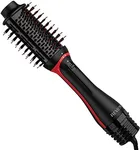Buying Guide for the Best Hair Brushes
Choosing the right hair brush can make a big difference in your daily hair care routine. The right brush not only helps you style your hair more easily, but it can also improve hair health by reducing breakage and distributing natural oils. When picking a hair brush, it's important to consider your hair type, the style you want to achieve, and how you plan to use the brush—whether for detangling, blow-drying, or finishing touches.Bristle TypeBristle type refers to the material and texture of the brush's bristles, which can be natural (like boar), synthetic (like nylon), or a mix of both. This is important because different bristles interact with hair in unique ways. Natural bristles are gentle and help distribute oils, making them great for fine or delicate hair. Synthetic bristles are stiffer and work well for detangling thick or curly hair. Mixed bristles offer a balance of both. To choose the right one, think about your hair's thickness and sensitivity—gentler bristles for fine hair, firmer ones for thick or curly hair.
Brush ShapeBrush shape refers to the overall design of the brush head, such as paddle, round, vented, or oval. This matters because each shape serves a different purpose. Paddle brushes are wide and flat, ideal for straightening and smoothing long hair. Round brushes are used for blow-drying and adding volume or curls. Vented brushes have openings that allow air to pass through, speeding up drying time. Oval brushes are versatile for general use. Choose a shape based on your styling needs—paddle for straightening, round for volume, vented for quick drying, and oval for everyday brushing.
Handle DesignHandle design includes the length, grip, and material of the brush handle. This is important for comfort and control, especially if you spend a lot of time styling your hair. Some handles are ergonomically shaped or have non-slip grips, which can make brushing easier and more comfortable. If you have small hands or limited dexterity, look for a handle that's easy to hold and maneuver. For those who style their hair frequently, a comfortable handle can make a big difference.
CushioningCushioning refers to whether the brush head has a soft, flexible base that allows the bristles to move. This feature is important for reducing scalp irritation and minimizing hair breakage, especially when detangling. Brushes with cushioning are gentle on the scalp and are a good choice for people with sensitive skin or those prone to hair breakage. If you have a sensitive scalp or want a gentler brushing experience, look for a cushioned brush.
SizeSize refers to both the overall dimensions of the brush and the length of the bristles. Larger brushes cover more area and are great for long or thick hair, while smaller brushes are easier to use on short hair or for detailed styling. Bristle length also matters—longer bristles can reach deeper into thick hair, while shorter bristles are better for fine or thin hair. Consider your hair length and thickness when choosing the size of your brush.














